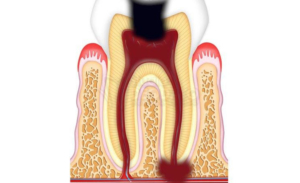Apical granuloma is one of those pathologies of the oral cavity that do not present any kind of symptoms and can progress over time without the slightest suspicion for the patient. Let’s go see it in detail.
What is apical granuloma?
When we talk about apical granuloma we mean the inflammation that involves the final part of the tooth root, the apex of the root.
The process by which the granuloma forms starts with the accumulation of bacteria around the root of the tooth.
In most cases the origin of the bacteria and toxins is to be located in the pulp chamber, therefore it is a matter of a gradual colonization by the bacteria. From the pulp of the tooth they travel to the root through a passage called the root foramen. Once they reach the apex of the root, they accumulate to form the granuloma.
How to recognize a granuloma?
Apical granuloma can only be diagnosed by orthopanoramics or intraoral radiography. The diagnostic images highlight a radiolucent area right in the root area of the tooth. In detail, it appears as an accumulation of soft tissue, with variable dimensions, from a few millimeters up to a centimeter in size.
Undergoing an x-ray is the only way to become aware of the presence of an apical granuloma.
An alarm bell can be represented by the presence of a deep caries and the resulting discomforts. When the caries reaches the dental pulp, sometimes causing the necrosis of the tooth, a defense mechanism is activated by which the accumulation of bacteria is pushed towards the apical part of the root of the tooth.
It can therefore be said that the accumulation of bacteria in the apical part of the tooth root is often the direct consequence of untreated caries. The pain can occur in alternating periods, or at least as long as the tooth is still alive. When the dental pulp goes into necrosis, you no longer feel any pain. The granuloma can therefore develop and progress without arousing any suspicion in the patient, up to the point in which serious health complications occur: the dental abscess or the spread of the infection towards the heart, lungs, liver through the blood vessels.
The importance of timely treatment
A tooth can be completely compromised by an infection, so much so that it has to be extracted, i.e. a permanent loss.
Obviously the best solution is to intervene in time and be able to apply a conservative therapy and therefore preserve the natural tooth. The dental treatment for the cure of granuloma is root canal treatment. The tooth is completely cleaned of the infection, to then be sealed again with a compound or resin, with the aim of restoring the chewing and aesthetic functions.
Pathologies of this kind can only be diagnosed by the expert eye of a dentist, regular check-ups can therefore save us from complicated situations. It is essential to rely on specialists such as those you find in our Sanident dental center in via Settembrini, 6, in Milan. Come and visit us and book a first visit without obligation.

















